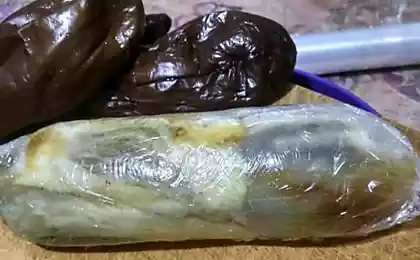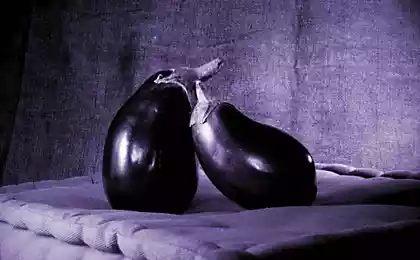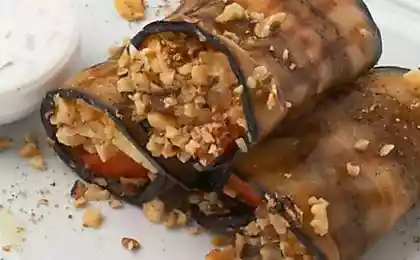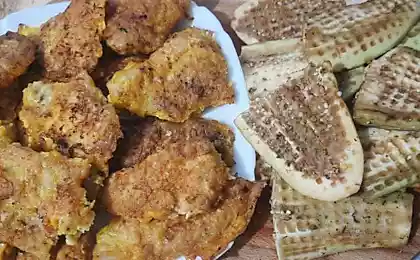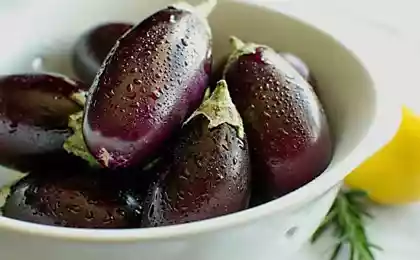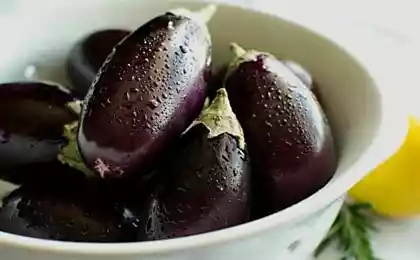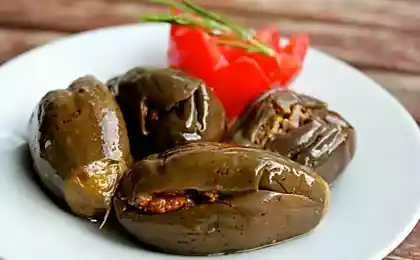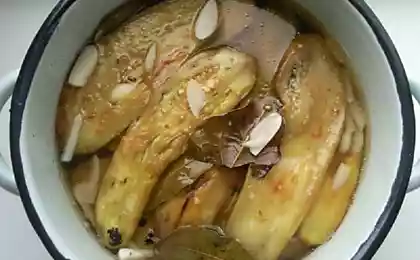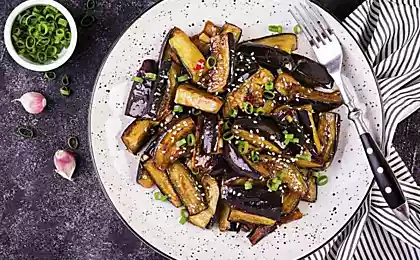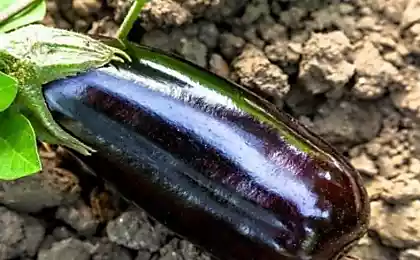557
Eggplant: the secrets of a great harvest
The cultivation of eggplant in many aspects similar to the care for tomatoes, although there are some differences.
Requirements to the soil.
Eggplant requires fertile soil. To do this, while digging add mineral and organic fertilizers. If the soil is so fertile, that in it, make humus after previous crops and fertilizers.

Eggplants grow better in light soil. Heavy soils promote the formation of compact bushes that is not always good.
Eggplants have a strong root system, which may result in the underdevelopment of the stems. In connection with this fertilizer should have an emphasis on potassium.
If the vines are weak, it is in fertilizers increase for some time in half the proportion of nitrogen. The soil should have an acidity of about 6.5 to 7.2.
Note that the eggplants are suffering from a lack of magnesium, therefore its presence in the main dressing is necessary.
Eggplant — growing seedlings
Eggplant does not tolerate transplanting, is suffering its root system, and therefore only the cultivation of seedlings is recommended immediately produce in peat pots, not diving. If not possible, then the picks should be made very carefully, with minimal damage to the root system.
Seeds sprout in 10-15 days. Seedlings without picks should be grown 40-45 days, if swordplay is inevitable — some 50-60 days. The optimum temperature for good seed germination +22...+26 With, as soon as the green shoots of the temperature is lowered to +13...+16 C, the roots developed more robust and sprouts are not stretched. After 5-6 days the temperature regime is again raised to +20...+25 C. And at this temperature they grow before planting in the ground. Before planting in the soil it is necessary to conduct the hardening of the seedlings in the sun for the pots with eggplant for 2-3 days to bring in the sun for 10-15 minutes 2-3 times a day.
Landing in open ground
Before you begin transplanting, the plot it is necessary to mark and make holes or grooves of the landing. The scheme of planting is quite simple — between rows should be 45— 50 cm and between plants in the row 25-30 cm
The finished hole (or groove) abundantly watered (from 1 to 3 litres per hole), and immediately after irrigation in moist soil planted seedlings and the holes (grooves) fall asleep the dry earth. This method will ensure good rooting and seedling survival rate. Every 2-3 days the seedlings should be well watered.
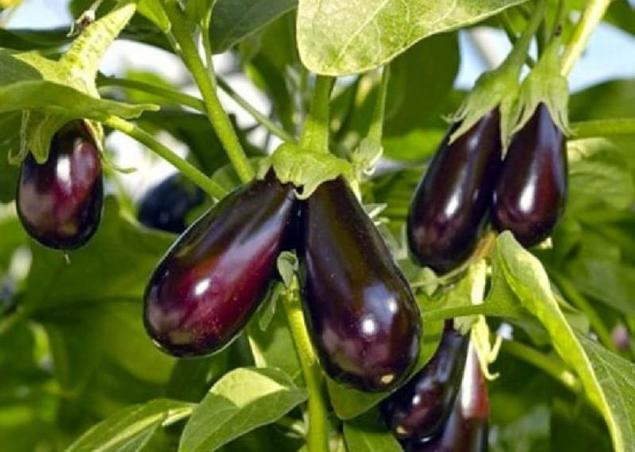
Dressing
During the growth of plants during the season can be from 3 to 5 feedings. The first feeding is about 2-3 weeks after planting of seedlings, early to make this unnecessary, since the weak roots are not able to absorb useful elements. Before the appearance of the fruit make dressing complex mineral fertilizers.
During fruiting, the use of nitrogen-phosphate fertilizers, which are made from 1 tbsp. l. superphosphate and 1 tsp. of ammonium nitrate dissolved in 10 liters of water. To superphosphate dissolves better in water and used to make a hood.
Organic fertilizer use in moderation, because they contribute to the growth of the stems, not the fruit. From fertilizer gardeners recommend "Bid", which is produced on the basis of mullein. The remedy is diluted in water in ratio of 1:20.
Substitute organic fertilizers can perebrannoe grass. For example, a suitable infusion of nettle, which insist 3-5 days, then filtered and diluted with water 1:2.
Also for feeding suitable mixture fertilizers for tomatoes and peppers, "Rastvorin" and "Robin Green".
Mineral and organic fertilization suggest to alternate.
In order to stimulate the growth of eggplant use foliar feeding through 12-15 days after planting.
During fruiting, the soil sprinkled with ash, and in the end the best fit to the calcium sulfate that is diluted in 10 liters of water per 1 tsp.
If bad is the bloom, the plant can spray boric acid dissolved in hot water.
If there is an excess of green mass, then feed the plant with potassium, and with a weak development in the quality of fertilizer take fertilizing with nitrogen.
During the wet and cool weather, you need to make foliar feeding of plants with micronutrients.
Watering
Watering eggplants need to exercise regularly, since they have greater need for moisture. The lack of moisture the plant fall fruits and flowers, and also stops the development.
For irrigation use warm water at a temperature at least 20 °C.
After the plant is planted, the first watering is carried out only after 5 days. Subsequently watering produce on a weekly basis.
In hot and dry weather, frequent watering.
You need to water the plant at the root, while trying not to wet lay and leaves.
Treatment
As processing plants produce a loosening of row spacing and are struggling with weeds. Eggplant is very demanding to heat, especially during the growing season, therefore, to cultivate aisle, it is often necessary that will promote good warming of the soil. For the season aisle loosened 4-5 times and the number depends on the nature of the soil and weather conditions. The first cultivation is carried out to a depth of 8-10 cm, and 10-12 cm in the following
Note that the depth of cultivation depends on the quality of the soil. If the soil is moist and dense, the first loosening do on the third day of planting to a depth of 6-8 cm, the subsequent processing is performed on 8-12 see
The formation of plants and the cultivation of eggplant in the open field
Medium - vigorous varieties of eggplant when grown tied after the stalk reaches a height of 30 cm When tying, keep in mind that the plant still grows and the thickness of the stem will increase, so leave the stock.
With the development of plants form three stem. After we generate the first strong lateral shoots, and their tie to the trellis once every 2-3 weeks depending on growth. Other side shoots, whose height less than 1 m, are removed.
Perhaps the most difficult and tedious the process is the removal of shoots. In fact, in the summer you can leave extra shoots that will reduce the growth and give additional benefits. To reduce saudinet plants, you need to remove near the tops of the stems for 2 small sheet.
It also works on the formation of plants refers to pinching of the secondary flowers and getting rid of the radar ring on the fruit, which will reduce the possibility of Botrytis. Leaves trimmed to reduce their density and thereby open to flowers the entry of light. The decrease in the number of leaves also helps to prevent the disease gray mold, as it improves ventilation in the landing. Remember that the appearance of secondary shoots, need to be removed immediately.
To take care of the hybrids and low-growing varieties of eggplant a lot easier. At the beginning of development, after the emergence of the first lateral shoots, select 2-3 of the strongest, and the rest are removed. Also on the main stem and remove all leaves and shoots that are below this junction. Above the fork, remove only those shoots that are not formed fruit, other leave.
It is also necessary to clean the bushes on the presence of the sick, yellowing of leaves and deformed fruit.
At the end of the season the tops of the stems pinch, leaving 5-7 small ovaries that are able to ripen before the first frost. Removal in this period is to be and emerging flowers.
If you follow these techniques, you can get big and good results in a short fall season.
In addition to the single flowers of the eggplant are formed in the forks of the stems, the whole inflorescence of 2-5 flowers. This ovary can leave one that promotes the growth of large fruit. Removing flowers does not change the overall harvest from the plant, as otherwise the fruit will simply be smaller.
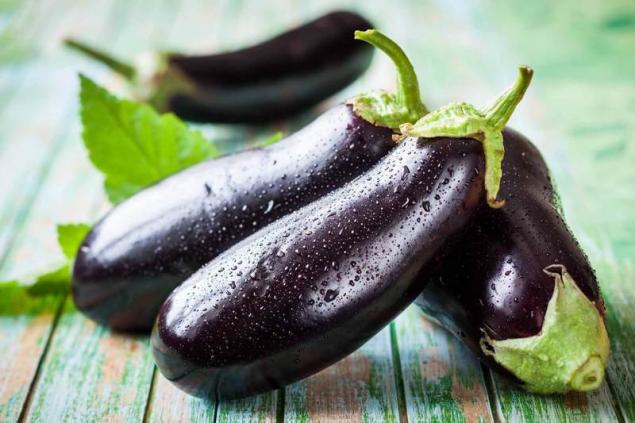
Also interesting: the Secrets of growing watermelons
How to grow organic cabbage crop — the secrets of experienced gardeners
Note that you should not blindly follow all the instructions, try to carefully watch the development of the plant. This will help you to understand intuitively, which is required by the plant at one time or another that in the end will result in high-quality, large and healthy crop.published
P. S. And remember, only by changing their consumption — together we change the world! ©
Join us in Facebook , Vkontakte, Odnoklassniki
Source: www.art-pen.ru/baklazhany-vyrashhivanie-i-uxod
Requirements to the soil.
Eggplant requires fertile soil. To do this, while digging add mineral and organic fertilizers. If the soil is so fertile, that in it, make humus after previous crops and fertilizers.

Eggplants grow better in light soil. Heavy soils promote the formation of compact bushes that is not always good.
Eggplants have a strong root system, which may result in the underdevelopment of the stems. In connection with this fertilizer should have an emphasis on potassium.
If the vines are weak, it is in fertilizers increase for some time in half the proportion of nitrogen. The soil should have an acidity of about 6.5 to 7.2.
Note that the eggplants are suffering from a lack of magnesium, therefore its presence in the main dressing is necessary.
Eggplant — growing seedlings
Eggplant does not tolerate transplanting, is suffering its root system, and therefore only the cultivation of seedlings is recommended immediately produce in peat pots, not diving. If not possible, then the picks should be made very carefully, with minimal damage to the root system.
Seeds sprout in 10-15 days. Seedlings without picks should be grown 40-45 days, if swordplay is inevitable — some 50-60 days. The optimum temperature for good seed germination +22...+26 With, as soon as the green shoots of the temperature is lowered to +13...+16 C, the roots developed more robust and sprouts are not stretched. After 5-6 days the temperature regime is again raised to +20...+25 C. And at this temperature they grow before planting in the ground. Before planting in the soil it is necessary to conduct the hardening of the seedlings in the sun for the pots with eggplant for 2-3 days to bring in the sun for 10-15 minutes 2-3 times a day.
Landing in open ground
Before you begin transplanting, the plot it is necessary to mark and make holes or grooves of the landing. The scheme of planting is quite simple — between rows should be 45— 50 cm and between plants in the row 25-30 cm
The finished hole (or groove) abundantly watered (from 1 to 3 litres per hole), and immediately after irrigation in moist soil planted seedlings and the holes (grooves) fall asleep the dry earth. This method will ensure good rooting and seedling survival rate. Every 2-3 days the seedlings should be well watered.

Dressing
During the growth of plants during the season can be from 3 to 5 feedings. The first feeding is about 2-3 weeks after planting of seedlings, early to make this unnecessary, since the weak roots are not able to absorb useful elements. Before the appearance of the fruit make dressing complex mineral fertilizers.
During fruiting, the use of nitrogen-phosphate fertilizers, which are made from 1 tbsp. l. superphosphate and 1 tsp. of ammonium nitrate dissolved in 10 liters of water. To superphosphate dissolves better in water and used to make a hood.
Organic fertilizer use in moderation, because they contribute to the growth of the stems, not the fruit. From fertilizer gardeners recommend "Bid", which is produced on the basis of mullein. The remedy is diluted in water in ratio of 1:20.
Substitute organic fertilizers can perebrannoe grass. For example, a suitable infusion of nettle, which insist 3-5 days, then filtered and diluted with water 1:2.
Also for feeding suitable mixture fertilizers for tomatoes and peppers, "Rastvorin" and "Robin Green".
Mineral and organic fertilization suggest to alternate.
In order to stimulate the growth of eggplant use foliar feeding through 12-15 days after planting.
During fruiting, the soil sprinkled with ash, and in the end the best fit to the calcium sulfate that is diluted in 10 liters of water per 1 tsp.
If bad is the bloom, the plant can spray boric acid dissolved in hot water.
If there is an excess of green mass, then feed the plant with potassium, and with a weak development in the quality of fertilizer take fertilizing with nitrogen.
During the wet and cool weather, you need to make foliar feeding of plants with micronutrients.
Watering
Watering eggplants need to exercise regularly, since they have greater need for moisture. The lack of moisture the plant fall fruits and flowers, and also stops the development.
For irrigation use warm water at a temperature at least 20 °C.
After the plant is planted, the first watering is carried out only after 5 days. Subsequently watering produce on a weekly basis.
In hot and dry weather, frequent watering.
You need to water the plant at the root, while trying not to wet lay and leaves.
Treatment
As processing plants produce a loosening of row spacing and are struggling with weeds. Eggplant is very demanding to heat, especially during the growing season, therefore, to cultivate aisle, it is often necessary that will promote good warming of the soil. For the season aisle loosened 4-5 times and the number depends on the nature of the soil and weather conditions. The first cultivation is carried out to a depth of 8-10 cm, and 10-12 cm in the following
Note that the depth of cultivation depends on the quality of the soil. If the soil is moist and dense, the first loosening do on the third day of planting to a depth of 6-8 cm, the subsequent processing is performed on 8-12 see
The formation of plants and the cultivation of eggplant in the open field
Medium - vigorous varieties of eggplant when grown tied after the stalk reaches a height of 30 cm When tying, keep in mind that the plant still grows and the thickness of the stem will increase, so leave the stock.
With the development of plants form three stem. After we generate the first strong lateral shoots, and their tie to the trellis once every 2-3 weeks depending on growth. Other side shoots, whose height less than 1 m, are removed.
Perhaps the most difficult and tedious the process is the removal of shoots. In fact, in the summer you can leave extra shoots that will reduce the growth and give additional benefits. To reduce saudinet plants, you need to remove near the tops of the stems for 2 small sheet.
It also works on the formation of plants refers to pinching of the secondary flowers and getting rid of the radar ring on the fruit, which will reduce the possibility of Botrytis. Leaves trimmed to reduce their density and thereby open to flowers the entry of light. The decrease in the number of leaves also helps to prevent the disease gray mold, as it improves ventilation in the landing. Remember that the appearance of secondary shoots, need to be removed immediately.
To take care of the hybrids and low-growing varieties of eggplant a lot easier. At the beginning of development, after the emergence of the first lateral shoots, select 2-3 of the strongest, and the rest are removed. Also on the main stem and remove all leaves and shoots that are below this junction. Above the fork, remove only those shoots that are not formed fruit, other leave.
It is also necessary to clean the bushes on the presence of the sick, yellowing of leaves and deformed fruit.
At the end of the season the tops of the stems pinch, leaving 5-7 small ovaries that are able to ripen before the first frost. Removal in this period is to be and emerging flowers.
If you follow these techniques, you can get big and good results in a short fall season.
In addition to the single flowers of the eggplant are formed in the forks of the stems, the whole inflorescence of 2-5 flowers. This ovary can leave one that promotes the growth of large fruit. Removing flowers does not change the overall harvest from the plant, as otherwise the fruit will simply be smaller.

Also interesting: the Secrets of growing watermelons
How to grow organic cabbage crop — the secrets of experienced gardeners
Note that you should not blindly follow all the instructions, try to carefully watch the development of the plant. This will help you to understand intuitively, which is required by the plant at one time or another that in the end will result in high-quality, large and healthy crop.published
P. S. And remember, only by changing their consumption — together we change the world! ©
Join us in Facebook , Vkontakte, Odnoklassniki
Source: www.art-pen.ru/baklazhany-vyrashhivanie-i-uxod
Attention! Plastic, pesticides, and carcinogens -10 dangerous products from China
7 French romantic comedies at all times


